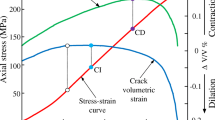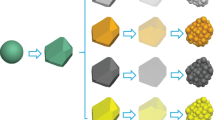Abstract
Crack initiation in uniaxial compressive loading of rocks occurs well before the peak strength is reached. The factors that may influence the onset of cracking and possible initiating mechanisms were explored using a discrete element numerical approach. The numerical approach was based on grain-based model that utilized the Voronoi tessellation scheme to represent low porosity crystalline rocks such as granite. The effect of grain size distribution (sorting coefficient ranging from 1.5 to 1.03), grain size (average grain size ranging from 0.75 to 2.25 mm), and the heterogeneities of different mineral grains (quartz, K-feldspar, plagioclase) on the onset of cracking were examined. The modelling revealed that crack initiation appears to be a tensile mechanism in low porosity rocks, and that shear cracking along grain boundaries is only a prominent mechanism near the peak strength. It was also shown that the heterogeneity introduced by the grain size distribution had the most significant effect on peak strength and crack initiation stress. The peak strength ranges from 140 to 208 MPa as the grain size distribution varies from heterogeneous to uniform, respectively. However, the ratio of crack initiation to peak stress showed only minor variation, as the heterogeneity decreases. The other factors investigated had only minor effects on crack initiation and peak strength, and crack initiation ratio.

















Similar content being viewed by others
References
Andersson JC, Martin CD, Stille H (2009) The Äspö pillar stability experiment: part II—rock mass response to coupled excavation-induced and thermal-induced stresses. Int J Rock Mech Min Sci 46(5):879–895
Ashby MF, Hallam SD (1986) The failure of brittle solids containing small cracks under compressive stress states. Acta Metall 34(3):497–510
Bass DJ (1995) “Elasticity of minerals, glasses and melts”. Ahrens TJ (ed) Mineral Physics and Crystallography, Reference Shelf 2, AGU, Washington, DC pp 45–63
Bieniawski ZT (1967) Mechanism of brittle fracture of rock: Part I—theory of the fracture process. Int J Rock Mech Mining Sci Geomech Abstr 4(4):395–404 IN11-IN12, 405-406
Brace WF (1961) Dependence of fracture strength of rocks on grain size. Bull Miner Inds Exp Stn Penn St Univ 76:99–103
Brace WF (1964) “Brittle fracture of rock”. In: Judd WR (ed) State of Stress in the Earth’s Crust, Elsevier, New York, pp 111–181
Brace WF, Paulding B, Scholz C (1966) Dilatancy in the fracture of crystalline rocks. J Geophys Res 71:3939–3953
Brown ET (1981) “Rock characterization, testing and monitoring, ISRM suggested methods”
Cho N, Martin CD, Sego DC (2007) A clumped particle model for rock. Int J Rock Mech Min Sci 44(7):997–1010
Cho N, Martin CD, Sego DC (2008) Development of a shear zone in brittle rock subjected to direct shear. Int J Rock Mech Min Sci 45(8):1335–1346
Christianson M, Board M, Rigby D (2006) “UDEC simulation of triaxial testing of lithophysal tuff”. In: Golden Rocks 2006, The 41st U.S. Symposium on Rock Mechanics (USRMS), 06-968-06-976
Cook NGW (1963) The basic mechanics of rockbursts. J S Afr Inst Min Metall 63:71–81
Cundall PA (1980) “UDEC—A generalised distinct element program for modelling jointed rock”. Rep. No. ADA087610, Peter Cundall Associates, European Research Office, U.S. Army Corps of Engineers
Cundall PA (2001) “A discontinuous future for the numerical modelling in Geomechanics” In: Proceedings of the ICE–Geotechnical Engineering, 149(1) pp 41–47
Cundall PA, Strack DLO (1979) A discrete numerical model for granular assemblies. Geotechnique 29(1):47–65
Diederichs MS (2007) The 2003 Canadian Geotechnical Colloquium: mechanistic interpretation and practical application of damage and spalling prediction criteria for deep tunneling. Can Geotech J 44:1082–1116
Diederichs MS, Kaiser PK, Eberhardt E (2004) Damage initiation and propagation in hard rock during tunnelling and the influence of near-face stress rotation. Int J Rock Mech Min Sci 41(5):785–812
Donzé FV, Richefeu V, Magnier S.-A (2009) “Advances in discrete element method applied to soil, rock and concrete mechanics”. Electr J Geotech Eng pp 1–44
D’yachkova AYa, Gorbenko VS, Kudryavtseva MN (1966) Elastic properties of alkali syenites from the October Massif. National Aeronautics and space administration, Washington, DC
Fredrich JT, Evans B, Wong T (1990) Effect of size on brittle and semi-brittle strength: implication for micromechanical modelling of fracture in compression. J Geophys Res 95:10907–10920
Glamheden R, Fredriksson A, Roshoff K, Karlsson J, Hakami H, Christiansson R (2007) “Rock mechanics Forsmark, Site descriptive modelling, Forsmark stage 2.2”. In: Swedish Nuclear Fuel and Waste Management Co., Rep. No. R-07-31, Stockholm, Sweden
Griffith AA (1921) “The Phenomena of Rupture and Flow in Solids. Philos Trans Royal Soc Lond Ser A Contain Papers Math Or Phys Character 221:163–198
Griffith AA (1924) “Theory of rupture”. In: Proceedings of the First International Congress of Applied Mechanics, pp 55–63
Hallbauer DK, Wagner H, Cook NGW (1973) Some observations concerning the microscopic and mechanical behaviour of quartzite specimens in stiff, triaxial compression tests. Int J Rock Mech Min Sci Geomech Abstr 10(6):713–726
Jian-An H, Sijing W (1985) An experimental investigation concerning the comprehensive fracture toughness of some brittle rocks. Int J Rock Mech Min Sci Geomech Abstr 22(2):99–104
Lajtai EZ (1974) Brittle fracture in compression. Int J Fract 10(4):525–536
Lajtai EZ (1998) Microscopic fracture process in a granite. Rock Mech Rock Eng 31(4):237–250
Lan H, Martin CD, Hu B (2010) “Effect of heterogeneity of brittle rock on micromechanical extensile behavior during compression loading”. J Geophys Res, p 115
Lan H, Martin CD, Andersson JC (2012) Evolution of in situ rock mass damage induced by mechanical–thermal loading. Rock Mech Rock Eng. doi:10.1007/s00603-012-0248-8
Lau JSO, Chandler NA (2004) Innovative laboratory testing. Int J Rock Mech Min Sci 41(8):1427–1445
Lim S, Martin CD, Åkesson U (2012) “In-situ stress and microcracking in granite cores with depth. Eng Geol 147:1–13
Martin CD, Chandler NA (1994) The progressive fracture of Lac du Bonnet granite. Int J Rock Mech Min Sci Geomech Abstr 31(6):643–659
Martin CD, Christiansson R (2009) Estimating the potential for spalling around a deep nuclear waste repository in crystalline rock. Int J Rock Mech Min Sci 46(2):219–228
Martin CD, Stimpson B (1994) The effect of sample disturbance on laboratory properties of Lac du Bonnet granite. Can Geotech J 31(5):692–702
Martin CD, Kaiser PK, McCreath DR (1999) Hoek-Brown parameters for predicting the depth of brittle failure around tunnels. Can Geotech J 36(1):136–151
Nemat-Nasser S, Horii H (1982) Compression-induced nonplanar crack extension with application to splitting, exfoliation, and rockburst. J Geophys Res 87(B8):6805–6821
Nemat-Nasser S, Obata M (1988) A micromodel of dilatancy in materials. Trans ASME J Appl Mech 55:24–35
Nicksiar M, Martin CD (2012) Evaluation of methods for determining crack initiation in compression tests on low-porosity rocks. Rock Mech Rock Eng 45(4):607–617
Nicksiar M, Martin CD (2013) Crack initiation stress in low porosity crystalline and sedimentary rocks. Eng Geol 154:64–76
Olsson WA (1974) Grain size dependence of yield stress in marble. J Geophys Res 79(32):4859–4862
Potyondy D, Cundall PA (2004) A bonded-particle model of rock. Int J Rock Mech Min Sci 41(8):1329–1364
Potyondy D, Cundall PA, Lee C (1996) “Modeling rock using bonded assemblies of circular particles”. Rock Mech Tools Tech pp 1937–1944
Prikryl R (2001) Some microstructural aspects of strength variation in rocks. Int J Rock Mech Min Sci 38(5):671–682
Read RS (2004) 20 years of excavation response studies at AECL’s underground research laboratory. Int J Rock Mech Min Sci 41(8):1251–1275
Read RS, Chandler NA, Dzik EJ (1998) In situ strength criteria for tunnel design in highly-stressed rock masses. Int J Rock Mech Min Sci 35(3):261–278
Scholtès L, Donzé F-V (2012) Modelling progressive failure in fractured rock masses using a 3D discrete element method. Int J Rock Mech Min Sci 52:18–30
Scholtès L, Donzé F-V (2013) A DEM model for soft and hard rocks Role of grain interlocking on strength. J Mech Phys Solids 61(2):352–369
Shimada M, Cho A, Yukutake H (1983) Fracture strength of dry silicate rocks at high confining pressures and activity of acoustic emission. Tectonophysics 96(1–2):159–172
Shin SW (2010) PhD Thesis, excavation disturbed zone in lac du bonnet granite. a thesis submitted to the faculty of graduate studies and research in partial fulfillment of the requirements for the degree of doctor of philosophy in geotechnical engineering, Department Civil and Environmental Engineering, University of Alberta, Edmonton, Canada, pp 1–247
Shin SW, Martin CD, Park ES, Christiansson R (2007) “Methodology for estimation of excavation damaged zone around tunnels in hard rock”. In: Eberhardt E, Stead D, Morrison T (eds), Proceedings 1st Canada-US Rock Mechanics Symposium, Vancouver, Taylor & Francis Group, London, vol 1. pp 485–491
Skinner WJ (1959) Experiments on the compressive strength of anhydrite. Engineer 207:255–259
Stacey TR (1981) A simple extension strain criterion for fracture of brittle rock. Int J Rock Mech Min Sci Geomech Abstr 18(6):469–474
Tapponnier P, Brace WF (1976) Development of stress-induced microcracks in Westerly Granite. Int J Rock Mech Min Sci Geomech Abstr 13(4):103–112
Trask PD (1932) Origin and environment of source sediments of petroleum. Gulf Pub, Houston
Acknowledgments
We would like to acknowledge the financial contribution of Swedish Nuclear Fuel and Waste Management Company through the DECOVALEX Project and the Synthetic Rock Project. The authors would like to thank Dr. Erik Eberhardt (University of British Columbia) for providing the stress–strain data of Lac du Bonnet granite and Yun Lu (University of Alberta) for his helps on creating some of the models.
Author information
Authors and Affiliations
Corresponding author
Rights and permissions
About this article
Cite this article
Nicksiar, M., Martin, C.D. Factors Affecting Crack Initiation in Low Porosity Crystalline Rocks. Rock Mech Rock Eng 47, 1165–1181 (2014). https://doi.org/10.1007/s00603-013-0451-2
Received:
Accepted:
Published:
Issue Date:
DOI: https://doi.org/10.1007/s00603-013-0451-2




